Richard Corben burst onto the fanzine scene in an earlier issue of this fanzine, Voice of Comicdom. His style and skill, virtually unmatched, made him an instant smash.
Voice of Comicdom 17: 1971
Publisher/Editor: Rudi Franke
I remember when I first saw Richard Corben’s work in 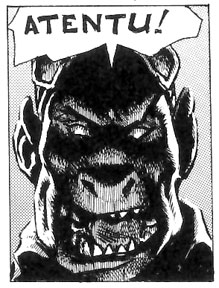 fanzines such as Infinity, and later, his own Fantagor (closer to an underground comic actually), his work screamed for attention just like the demon to the right and hit me like a ton of bricks (sort of related to how some might describe the figures of his female characters). The images were lusty, alive, cinematic, full of action, and rendered with incredible skill. He could paint rings around his contemporaries almost from the beginning. I remember wondering, how does he make everything so realistic, so three dimensional and so otherworldly? Because of this sense of wonder, I searched for his work wherever possible, whether it would appear in fanzines or, forbidden to a youngster like myself, the sometimes x-rated world of underground comics.
fanzines such as Infinity, and later, his own Fantagor (closer to an underground comic actually), his work screamed for attention just like the demon to the right and hit me like a ton of bricks (sort of related to how some might describe the figures of his female characters). The images were lusty, alive, cinematic, full of action, and rendered with incredible skill. He could paint rings around his contemporaries almost from the beginning. I remember wondering, how does he make everything so realistic, so three dimensional and so otherworldly? Because of this sense of wonder, I searched for his work wherever possible, whether it would appear in fanzines or, forbidden to a youngster like myself, the sometimes x-rated world of underground comics.
From Fershid Bharucha’s Richard Corben: Flights into Fantasy, Corben’s beginnings “as the artist remembers it.”
The American Midwest. The early forties. In a farmhouse in rural Anderson, Missouri, Rich is born and lives with his parents…’til the farmhouse burns down. So they pack up what’s left and move to Sunflower, Kansas, where a new town has sprung up around the Sunflower Ordnance Works. The time is World War II and everyone in town is making gunpowder and bombs for Uncle Sam. Rich goes through grade school in Sunflower. It is a very small town: one grocery store and a theater that only opens occasionally. But the grocery store has comics and Rich reads Superman. He really loves Superman. Then the family moves to Kansas City, where Rich goes to high school and later to art college [Kansas City Art Institute]. Somewhere along the way he meets Dona and they fall in love and get married and have a beautiful baby. And Rich draws and Dona collects owls and their daughter goes to school in nearby Indian Creek. And they all live happily ever after in a condominium on the Missouri side of Kansas City.
While reveling in the domestic bliss of his family, Corben served a few months in the Army Reserves, and then worked for a period of nine years in the animation department of Calvin Communications. While there, he continued to hone his skills in many areas of art, including painting, sequential work, and making short animated films of his own. As for his fanzine work, in 1969, Richard’s work appeared in several, including Weirdom and an early issue of Voice of Comicdom.
I confess I do not have any issues of VOC before issue 17 (issue 16 featured part one of the story you see here). The fanzine was closer to a newspaper until late in its run, when it started focusing on specific artists. In fact, Richard’s first published strip, Monsters Rule, appeared in an early issue of VOC. At the same time Corben was publishing fanzine work, he made his way into the new underground comix scene with work in Last Gasp and several others. Very soon after, Warren publications came calling and his work started appearing in those magazines as well. Regarding VOC, again from Bharucha’s book:
Fanzine publisher Rudi Franke ran “Monsters Rule”, the first Corben strip to see print, in the June 1968 issue. It ran as a serial, ending in the May 1969 issue. Rudi knew he was on to a good thing, and in the same issue he published an eight-page Corben story, rendered on scratch-board (“The Lure of the Tower“). The next two issues had full-color wraparound Corben covers and the two parts of the now-famous Rowlf, with a script by Harvey Sea (R.V.C., get it?). Then Rudi disappeared with some ten pages of Richard’s unpublished artwork. But that’s fandom!
Rowlf was reprinted in two places I have heard of, Last Gasp and a Warren magazine, but both are hard to find, so I hope you enjoy the download, including the color covers!
Corben succeeded in so many ways with his work in general and this story in particular (in fact, Moebius considers it Corben’s best). His forms are round, full of volume, and it is evident when weight is being applied (or when faces are being squashed!). It’s common knowledge that his storytelling abilities are excellent, which he infuses with a cinematic touch. I know I would be interested in seeing a film directed by Corben! In Bharucha’s book, Neal Adams says of Corben’s storytelling ability, “He tells stories the way a filmmaker makes a film, with proper sequencing and animation. He keeps his camera at the right level, he zooms and pans; he is a consummate film person.” Note all the various changing points of view below (as well as the still experimental background sharing of panels 3 and 4).
Corben is also very well known for his expert handling of lighting and shadows, often sculpting versions of his characters beforehand to see how those figures would react to light (see Ink Stains 11). I can remember being almost as enthralled with those sculptures as with the finished art! Those sculptures were sort of a glimpse behind the wizard’s curtain. It was a behind the scenes tutorial of sorts and inspirational seeing these amazing creatures in three dimensions.
Another critical element in the action packed world of comic book storytelling is the fight scene. A well staged fight scene can make all the difference in keeping the reader involved in the action and the characters. Corben is and has always been highly concerned with realistic fight scenes. He shoots them from a variety of viewpoints, injects an understanding of martial arts into the actual stances and moves, and does not hesitate to show the effects of, for example, a foot hitting a face. Just look below.
More samples from the story below.
Check out the emotion showing through Rowlf’s shepherd face! Not an easy thing to accomplish. More examples below.
Another aspect of Corben’s black and white art that always enhanced the story was his use of toning tools of the day. Whether it is crosshatching, zip-a-tone, duo-shade, or wash painting, you could tell he was always thinking of ways and tools to make the visuals sing. Check out the almost Parrish-like clouds in the vista below.
Jan Strnad, Corben’s frequent collaborator, probably puts it most eloquently as to what makes a Corben story so singular when he is quoted in Bharucha’s book as saying:
…it is his skillful manipulation of face and figure tha
t makes his characters so much fun to direct. They can act – displaying their emotions openly and convincingly – and they interact so completely with their environment as to blur the line of distinction between illustration and reality. Once they appear on the illustrated page they begin to demand respect as living individuals, and their destinies are no longer wholly in the hands of the writer but are determined in great part by the characters themselves. Once begun, writing a Corben series becomes an adventure of discovery with the writer in the back of the canoe, steering for all he’s worth, while the raging waters carry him where they will.
Please check out Corben’s own site here. You can see a web printing of the first installment of this story here. And of course, download the pdf right now, Jethro! See a few images below of Corben from The Bharucha book (printed in 1981).
Ken Meyer Jr.
kenmeyerjr@yahoo.com

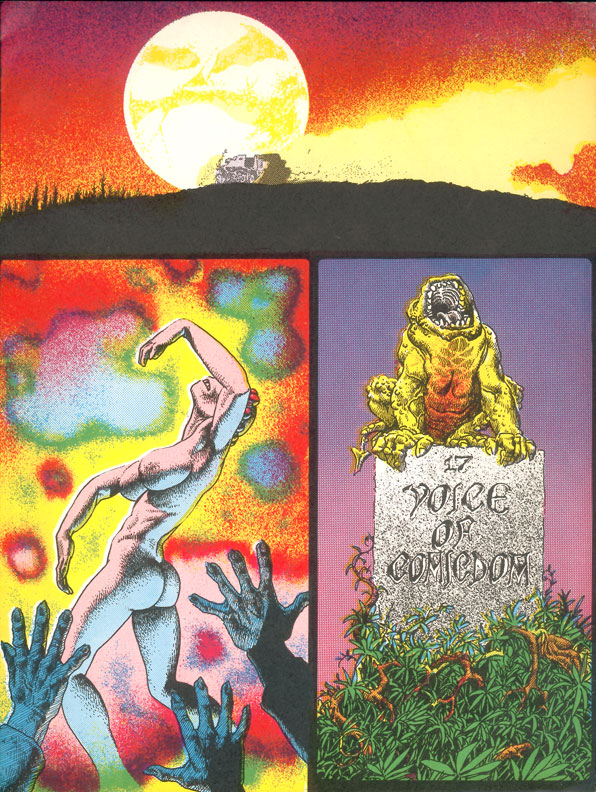
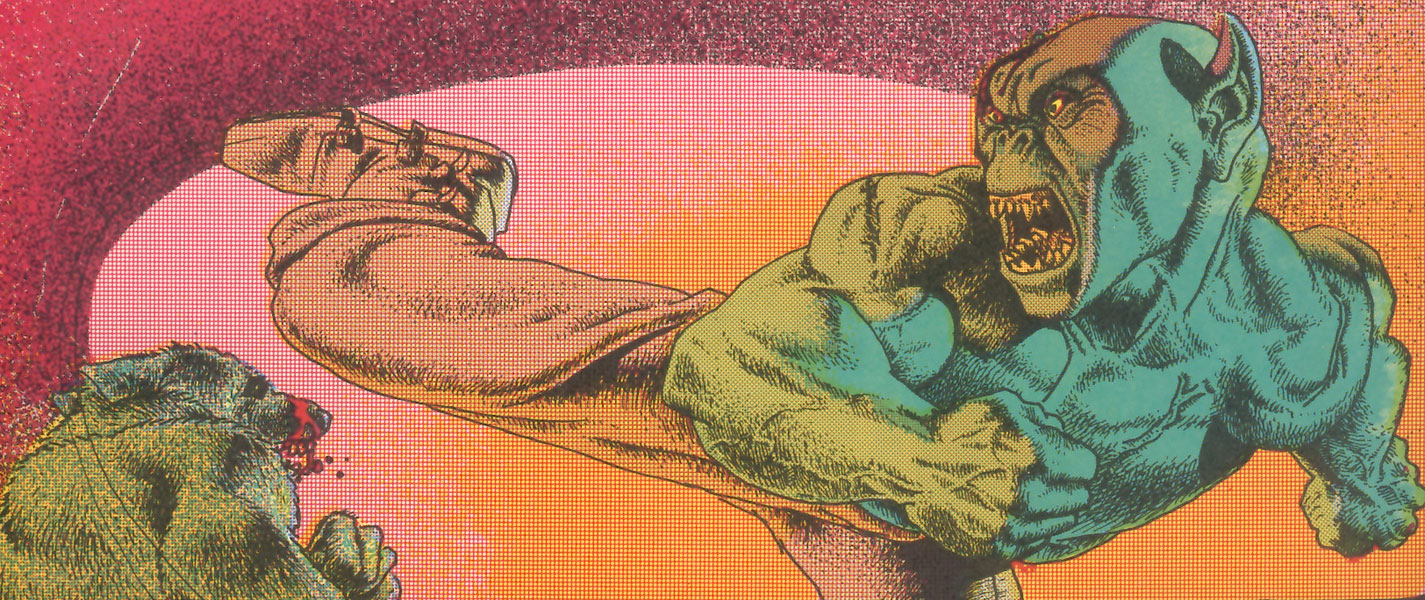
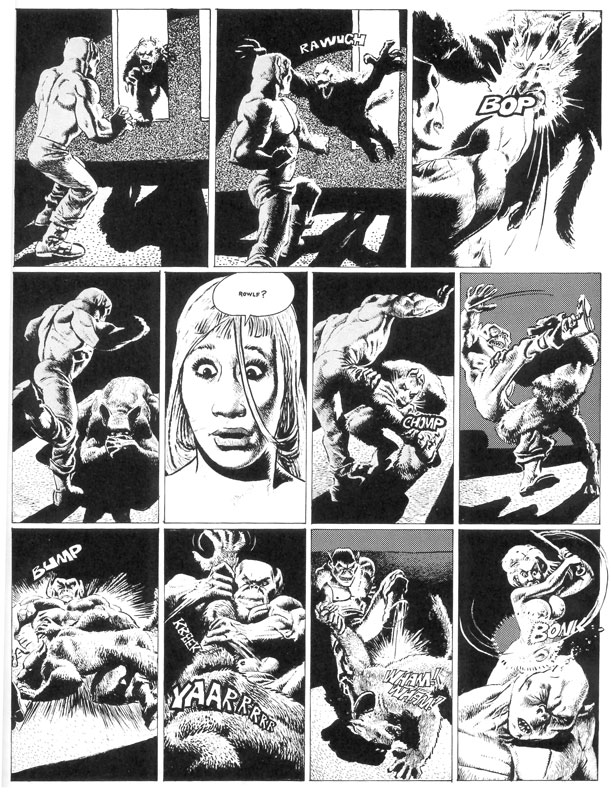
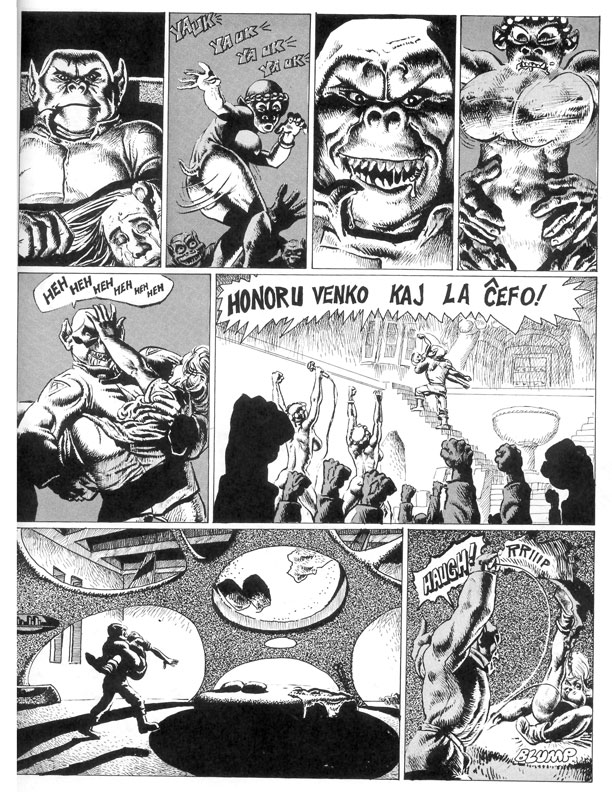

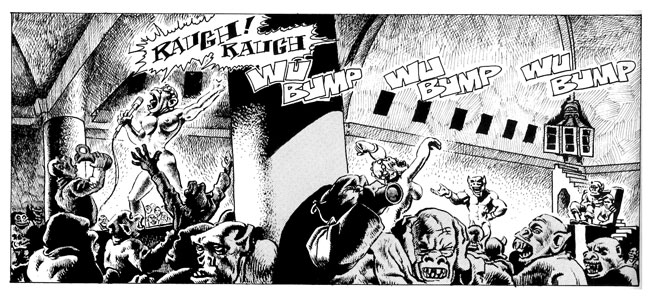
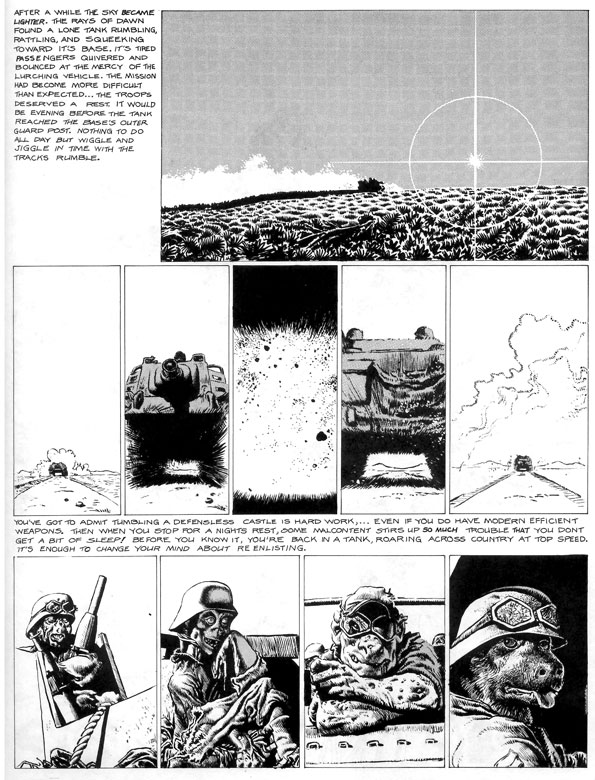
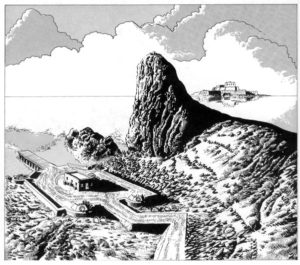
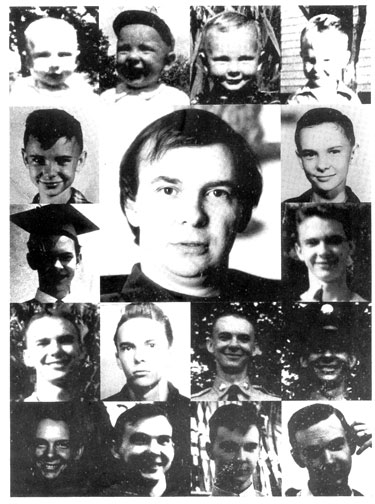
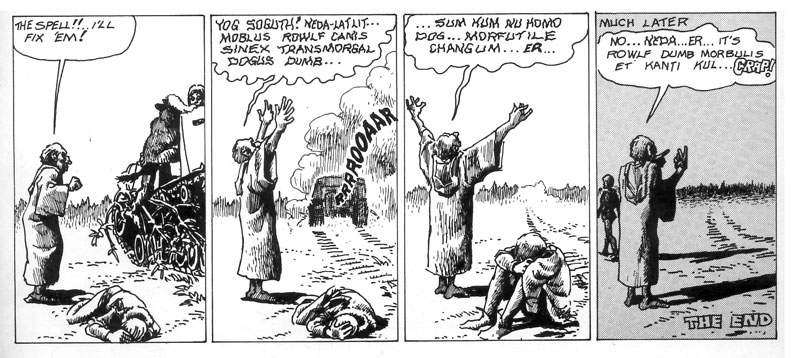


It appears the link to the pdf is not working…a minor fix, I am sure…will do this later today, when I have access to my computer.
fixed!
This is the best one yet. How great to have a copy of ROWLF again. I’ve always thought this should be made into a movie.
Man, Ellis, can you imagine the special effects needed for that??? As I said to someone else, I have a copy of Fantagor I might do as well….stretching the boundaries of what could be considered a fanzine.
I do have an issue on Anomaly (Jan Strnad’s zine) coming in the mail…and I know that will have more Corben!
Pingback: Tweets that mention Ink Stains 20: Voice of Comicdom 17 -- Topsy.com
The complete Rowlf story can also be found in either Underground Volume 2 or 3, published by Catlan. There was supposed to be a Volume 4 of these album-sized colelctions but I don’t think it ever appeared.
Didn’t Rudi Franke do some illustrations or back covers for The Comics Journal in its earlyish days?
Yeah, Paul, I thought I remembered his name as an artist as well.
This is a cool article. We have been Corbin fans for a long time but my husband is a true fan. He has a lot of his books including Rowlf. I really enjoy Corbin’s use of type and onomatopoeia.
I did not know until your article that he used to work at an animation studio.
Yeah, Christina…I think that helped his art a lot. Many artists come out of animation being much better artists (I can remember thinking that about Paul Smith years ago). On Corben’s site, you can actually see those short films he made long ago…it is quite a trip.